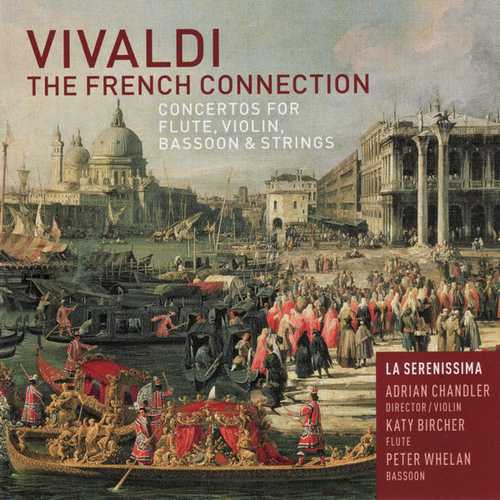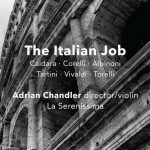
Composer: Antonio Vivaldi
Performer: La Serenissima, Peter Whelan, Katy Bircher
Conductor: Adrian Chandler
Format: FLAC (tracks)
Label: Avie
Catalogue: AV2178
Release: 2009
Size: 402 MB
Recovery: +3%
Scan: cover
Concerto for strings No. 5, RV 114
01. I. Allegro
02. II. Adagio
03. III. Ciacona
Concerto for bassoon, strings & continuo in F, RV 488
04. I. Allegro non molto
05. II. Largo
06. III. Allegro
Concerto for violin, strings & continuo in C, RV 185, Op. 4 / 7
07. I. Largo
08. II. Allegro
09. III. Largo
10. IV. Allegro
Concerto for flute, strings, bassoon & continuo in G, RV 438
11. I. Allegro
12. II. Andante
13. III. Allegro
Concerto in G minor RV157
14. I. Allegro
15. II. Largo
16. III. Allegro
Concerto fragment for bassoon, strings & continuo in C, RV468
17. I. Allegro
18. II. Andante
19. Concerto fragment for flute, strings & continuo in E Minor, RV 432: I. Allegro
Concerto for flute, violin, bassoon & continuo in F, RV 100
20. I. Allegro
21. II. Largo
22. III. Allegro
Concerto for strings No. 3, RV 119
23. I. Allegro
24. II. Largo
25. III. Allegro
Concerto for violin, strings & continuo in D, RV 211
26. I. Allegro non molto
27. II. Larghetto
28. III. Allegro
After the extremely successful and acclaimed series ‘The Rise of the North Italian Violin Concerto’ Adrian Chandler and La Serenissima return to AVIE to explore another side of Vivaldi’s compositions : The French Connection.
“The voracity with which the French devoured Italian music during the late baroque period is well documented. Vivaldi was involved in both the dissemination of the French style in Italy and that of the Italian style in France. His works achieved fashionable status there in the late 1720s thanks to his concertos Le Quattro Stagioni which became a feature at the popular Concert Spirituel (between 1728 and 1763).” Adrian Chandler
The “French Connection” mooted by this release is pretty thin. It rests partly on a trio of Vivaldi’s “Paris” concertos for strings and continuo, so called because they come from a Parisian manuscript. That wasn’t surprising, for there eventually was quite a vogue for Vivaldi’s music in France, with publishers issuing genuine and spurious collections of his work.
Beyond that, there are pieces that have alleged hints of French style, such as dotted rhythms or dance-like movements resembling those of a French suite. It doesn’t add up to much; there’s a lot more French influence in Bach’s music than there ever was in Vivaldi’s, and Vivaldi was popular among the Parisians precisely because his music was exotic. That said, this is an attractive collection of Vivaldi concertos for various instruments, with several lovely examples of the composer’s ever-innovative treatment of the bassoon beautifully rendered by bassoonist Peter Whelan. A lot of the credit goes to the engineers, working in an old hospital that one imagines as sonically consistent with the “orphanage” or home for well-off unwed mothers where Vivaldi spent much of his career.
The recording creates a spacious ambience that lays open the playing of the British period-instrument group La Serenissima, exposing the solos and making the most of the relaxed quality of the group’s playing. The slow movements involving the bassoon are especially pleasing, with instrument traces quietly murmuring lines, backed by precise but low-key strings. It’s an unusual sound, state of the art in terms of performance practice yet entirely different in effect from slashing Italian interpretations. This is well worth sampling for Vivaldi fans, as long as they’re not expecting some kind of revelation of French style in Vivaldi’s music.



